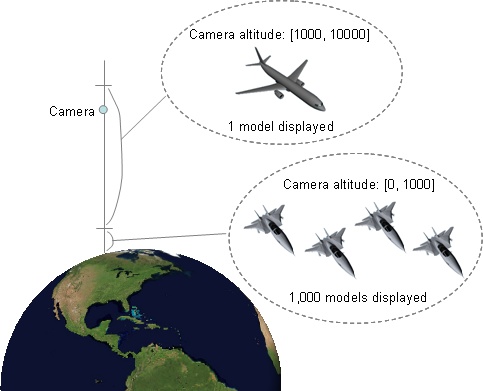
Composite primitives group primitives together to create hierarchies of primitives for layering and aggregation/deaggregation.
Efficient rendering is achieved because primitives in the same composite are put into a bounding volume hierarchy (BVH), which enables efficient culling using view frustum and horizon culling.
Layering is showing/hiding groups of primitives in the same general area based on display conditions. This is commonly used to show more detailed primitives as the camera becomes closer. Aggregation and deaggregation extend the layering concept so it appears that primitives expand into more primitives or collapse into less. This is frequently done based on distance to a reference point or camera altitude as the following example demonstrates.
For efficient display condition evaluation, primitives that share the same condition can be combined using a composite primitive. For example, consider primitives with two different constraints:
When the camera zooms out, 1 model represents 1,000 models.

If these primitives are added to the primitive manager individually, 1,001 primitives need to be visited when the scene is rendered, regardless of camera position. This is grossly inefficient once the camera's altitude is above 1,000 meters.
If the 1,000 models are added to a composite primitive instead, only 2 primitives need to be visited in this case (1 for the composite and 1 for the model that is rendered). This is shown in the example code below.
| [C#] |  Copy Code Copy Code
|
|
|---|---|---|
|
||
Since composites are primitives themselves, you can add composites to composites to build hierarchies that efficiently find and render the correct primitives based on display conditions.
STK Programming Interface 11.0.1